It's all about the classical music composers and their works from the last 400 years and much more about music. Hier erfahren Sie alles über die klassischen Komponisten und ihre Meisterwerke der letzten vierhundert Jahre und vieles mehr über Klassische Musik.
Total Pageviews
Friday, June 14, 2024
Strauss: Also sprach Zarathustra / Dudamel · Berliner Philharmoniker
Richard Strauss
by Georg Predota, Interlude
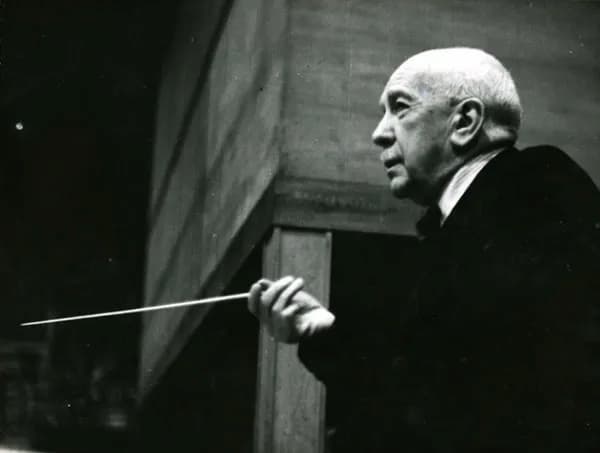
Richard Strauss conducting
Born on 11 June 1864 in Munich, Germany, Richard Strauss (1864-1949) almost exclusively expressed his life and thoughts through music and the arts. From his glorious summation of 19th-century Romanticism to the deeply probing psychological experimentations of 20th-century Modernism, his long career spanned one of the most chaotic political, social, and cultural periods in human history. To celebrate his birthday, let’s explore the magnificent compositions of one of the most versatile, talented and creative forces in the history of music and culture.
Juvenilia
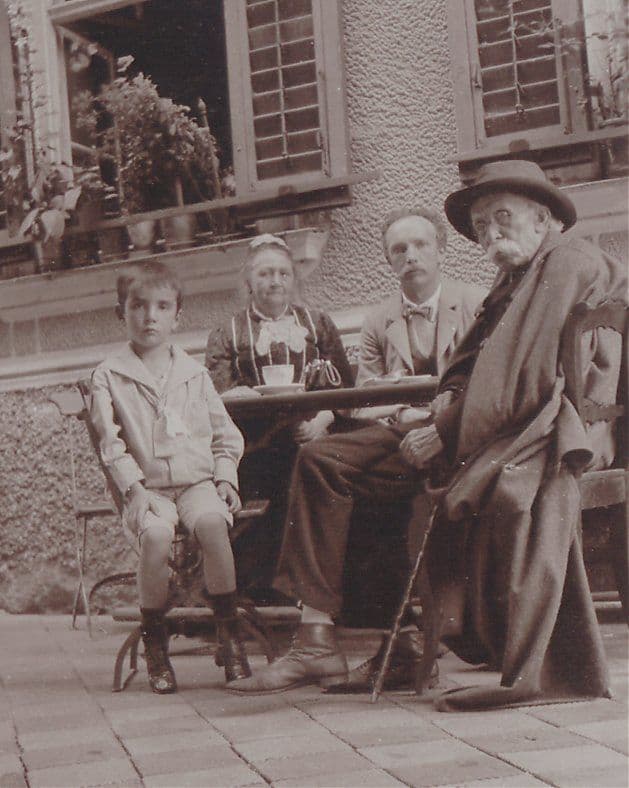
Richard Strauss and parents
Richard’s father Franz Strauss, a member of the Royal Court Orchestra in Munich and a celebrated horn virtuoso, quickly recognized the exceptional musical talents of his son. He started piano lessons at four and a half and made swift progress. Richard was also eager to try his hands at composition, and at the tender age of six, he composed a little polka for solo piano. He took up the violin under Benno Walter at age 8 and began five years of compositional study with Friedrich Wilhelm Meyer at age 11.
Young Richard was primarily interested in orchestral music, and his early instrumental works include marches, concert overtures and ultimately two symphonies. His Serenade for 13 Winds, Op. 7, composed when he was 17, led conductor Hans von Bülow to famously proclaim, “Richard Strauss is by far the most striking personality since Brahms.” Within this early phase of Richard Strauss’s career, we also find a number of works featuring solo instruments. The Violin Concerto Op. 8 was written for his teacher Benno Walter, and the Horn Concerto Op. 11 for his father.
Burleske
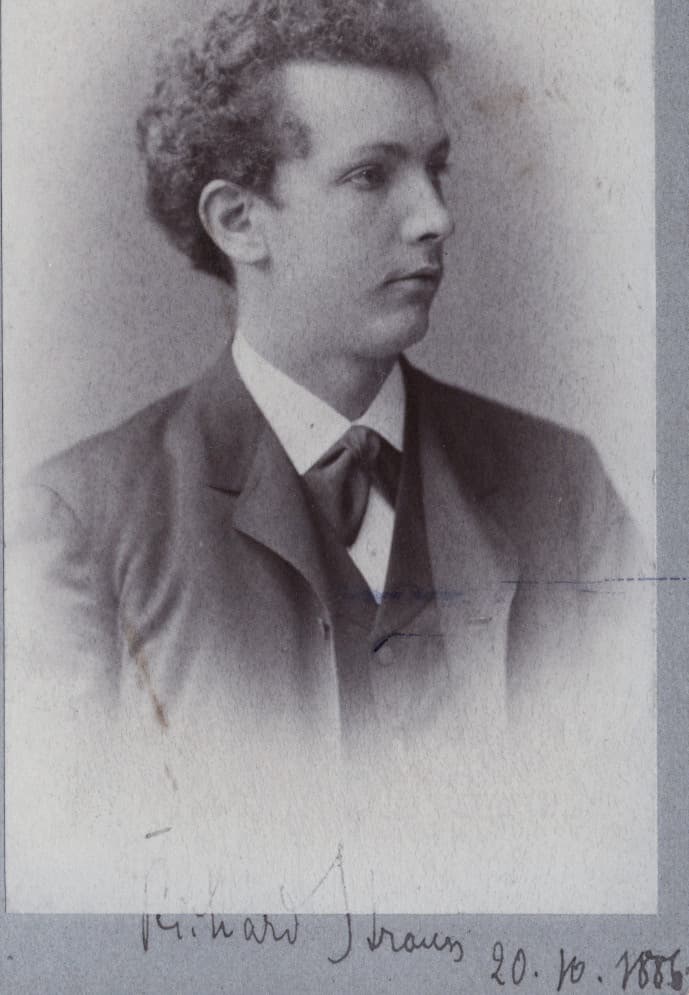
Richard Strauss at 22 years old, 1886
The Burleske, first performed in 1886, was dedicated to Bülow and “is one of the earliest pieces to use the historical canon as a source of parody, simultaneously burlesquing both piano concertos by Brahms and Tristan and Die Walküre by Wagner.” Strauss’s artistic sensibilities were developing with great rapidity, and he confessed to “feeling trapped in a steadily escalating antithesis between poetic content and formal structure.”
After spending several weeks touring Italy, Strauss sketched his tonal impressions to be used for his “first hesitant steps” into the realm of the tone poem. After the completion of Aus Italien in 1886, he jubilantly wrote to Bülow, “I am now capable of composing works based on external inspirations. New ideas must seek new forms.” Frequently described as a first step towards independence, Aus Italien gave rise to a series of magnificent works that represent a significant body of music of central importance in the late German Romantic repertoire. Play
The Tone Poems
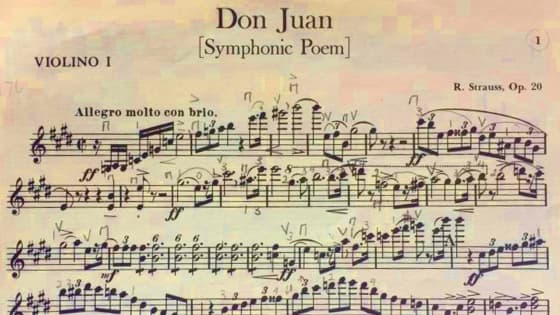
Richard Strauss’ Don Juan
Richard Strauss’s monumental tone poems, essentially written during a ten-year period from 1888 to 1898, fused the sheer force of Strauss’ imagination with his embrace of an aesthetic of program music that denounced traditional, abstract musical form as obsolete. In fact, Strauss crafted the central musical expressions of the Austro-German tradition at the turn of the century. These highly innovative orchestral works—ranging from Macbeth of 1888 to the Sinfonia domestica of 1903—with Eine Alpensinfonie added in 1915—project youthful confidence and virility in its music handling, but also in subject matters.
Don Juan (1889), with its provocative subject matter, dazzling orchestration, sharply etched themes, novel structure and taut pacing, earned Strauss his international reputation as a symphonic composer. Cosima Wagner, who was an early admirer of Richard Strauss, was deeply offended by the blatantly erotic subject matter. Although Wagner and Liszt had initially inspired Strauss to embrace the extra-musical, the young composer was determinedly and irreverently carving his own musical path.
Ein Heldenleben
Throughout his life, Strauss had been attracted by the philosophies of Friedrich Nietzsche, and he was especially partial to the notion that the “individual had the power to change the world around him, and was able to control his destiny without promise of a hereafter.”
For Strauss, the genius of Nietzsche found its greatest manifestation in his book Thus Spoke Zarathustra. Mirroring the nature and character of this literary source, Strauss musically depicts humanity not in search of eternity, but rather struggling to transcend religious superstition.
With his three last and largest tone poems, particularly with Ein Heldenleben (1899), Strauss faced mounting criticism, charges of excess, megalomania, superficiality, and bad taste. A Hero’s Life should not be read as a musical autobiography, however, as the music is much more psychologically complex than its showy and grandiose surface at first suggests. It is principally concerned with exploring the inner world of personality, emotion, and psychology; all deeply embedded in lush layers of irony and parody.
The Operatic Stage
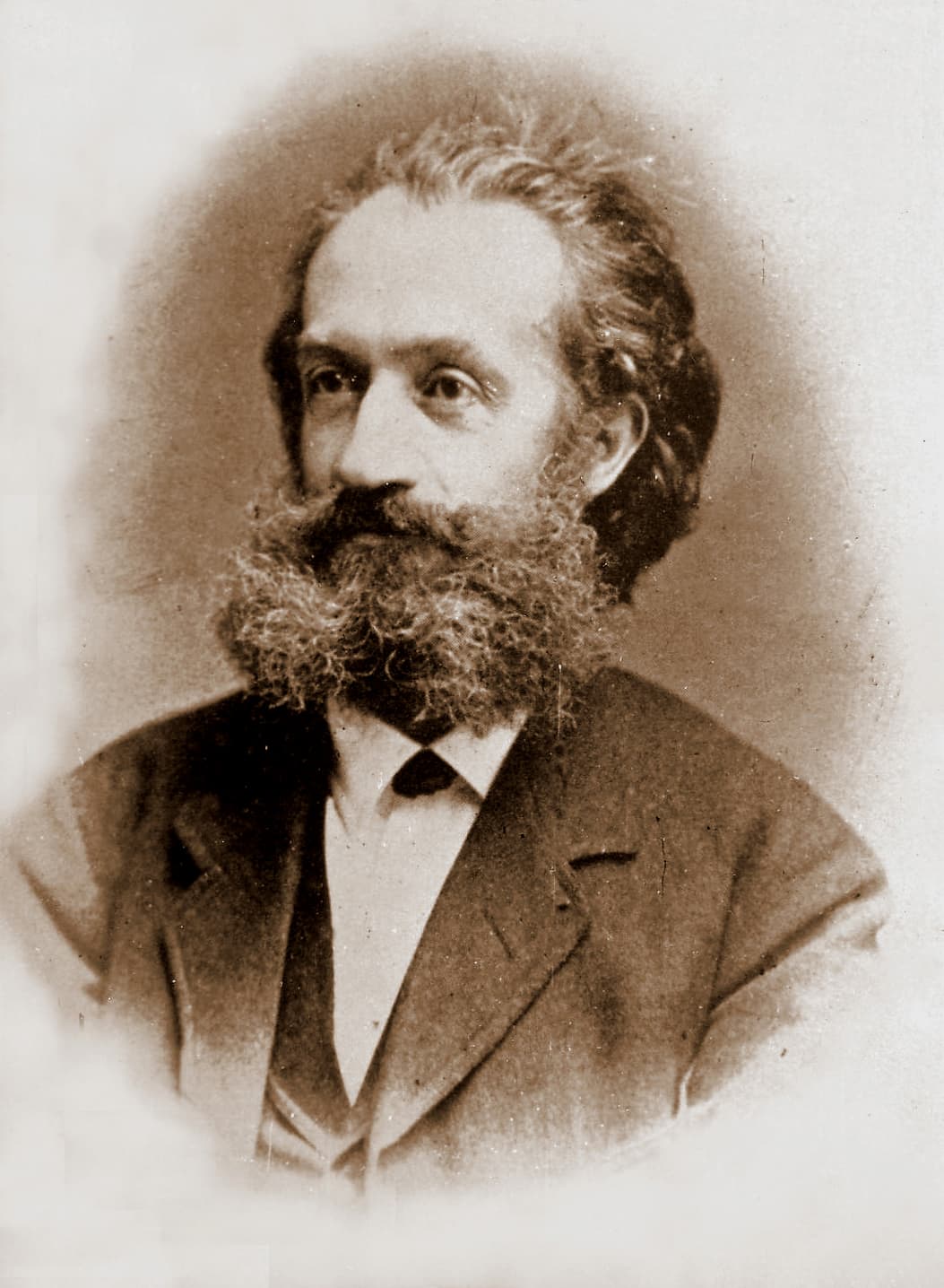
Alexander Ritter
Young Richard Strauss had grown up under the archconservative direction of his father Franz, who never missed an opportunity to rail against Richard Wagner’s music. When Richard Strauss took up his appointment with the Meiningen orchestra, he met the Estonian-born Alexander Ritter, who had married the niece of Richard Wagner. Ritter took an immediate liking to the young Richard, and began to engage him on the aesthetic beliefs of Liszt and Wagner, both of whom he regarded almost as gods. In his memoirs, Strauss credited Ritter with his so-called “conversion” to Wagner and the music of the future.
Ritter provided Strauss with an aesthetic focus for his creative energies, and above all, spurred the young composer to devote himself to the musical theatre. After the dismal failure of his first opera Guntram (1894) and the scandal caused by the sexual and erotic subtext of Feuersnot (1901), Strauss’s next opera, Salome (1905) simultaneously provoked fascination and revulsion. “Lust, incest, decapitation, and necrophilia is wrapped in a lush tapestry of dazzling orchestration,” and decidedly established Strauss as the leading German opera composer of his time. Elektra (1909), in turn, proved crucial to Strauss’s later development as a composer of opera, since it marked the beginning of his collaboration with the young Viennese poet Hugo von Hofmannsthal.
Der Rosenkavalier
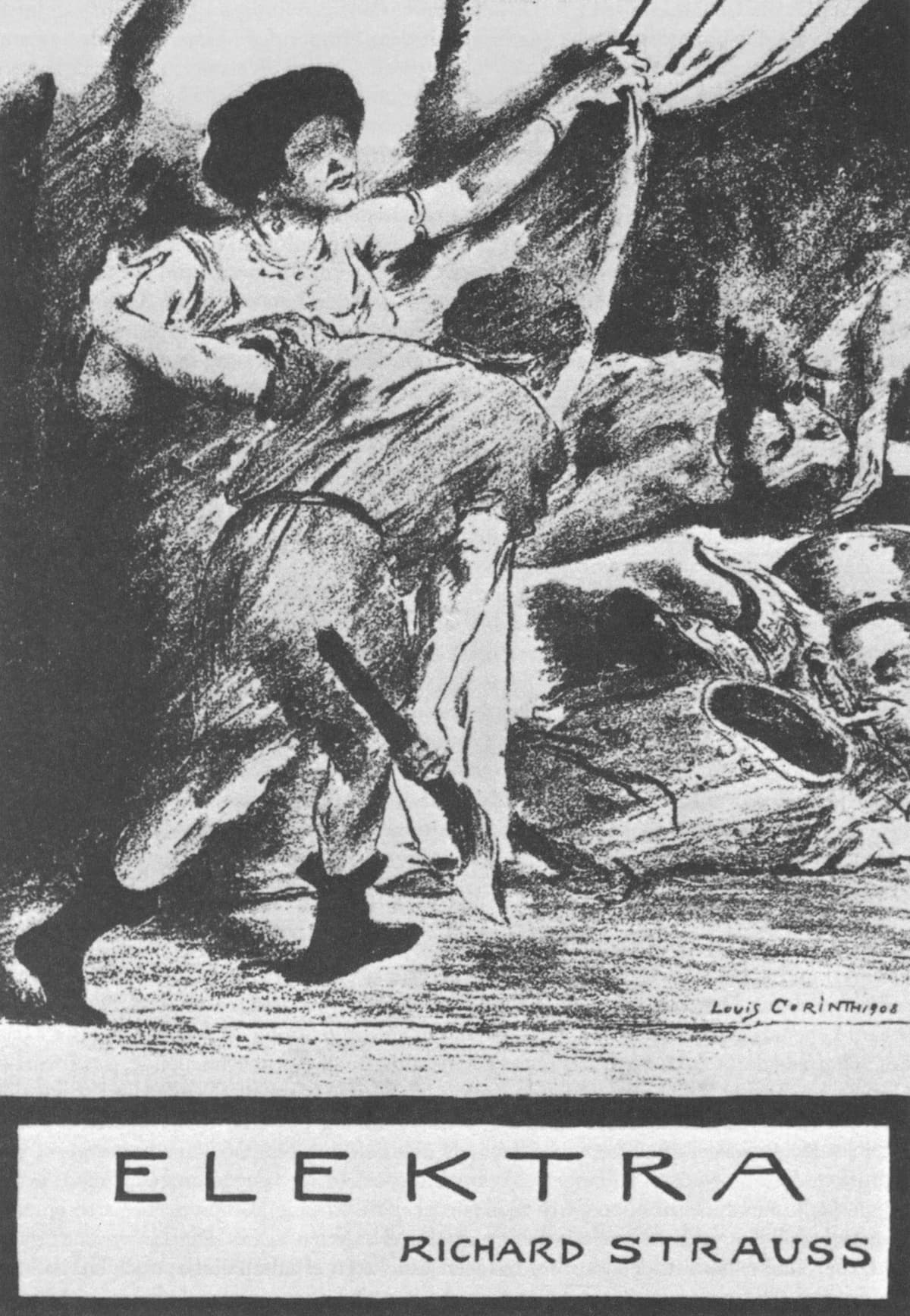
Richard Strauss’ Elektra, title page of the libretto, 1909
In terms of popularity, nothing comes close to Der Rosenkavalier (1911). Collaborating once more with Hofmannsthal, Strauss turned to 18th-century Vienna and the musical world of Mozart. This comic opera presents a critical layering of musical styles, referencing Mozart, Verdi, and the waltzes. It evokes a sense of sentimentality and denotes the middle-class sensibilities of Johann Strauss. Strauss essentially discloses his modernist preoccupation with the dilemma of history, and the popularity of the score has overshadowed the theatrical brilliance and modernity of the work.
Strauss further exploits the musical canon as a source of parody in Ariadne auf Naxos (1916), while Die Frau ohne Schatten (1919) is a complex mixture of operatic and musical elements. Based on a fairytale, the complexity of the libretto inspired Strauss to compose one of his densest scores, packed with intricate leitmotifs and brilliant orchestral colours. The comedy Intermezzo (1924), on the other hand, was inspired by Strauss’s wife mistakenly accusing him of philandering, while Die Ägyptische Helena (1928) returns to the more elevated world of Greek myth. Although Strauss referred to Die Liebe der Danae (1944) as his last opera, his final completed work for the stage was a “Conversation Piece for Music,” entitled Capriccio (1942). Rich in historical allusions and self-references, it represents the culmination of the composer’s work in this genre. Play
Vocal Musings
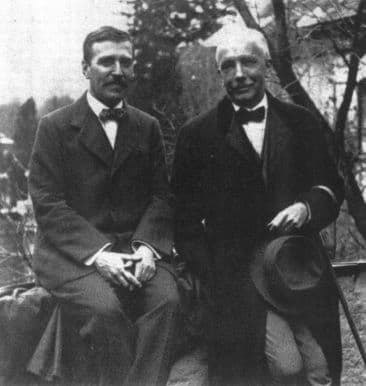
Richard Strauss with Hugo von Hofmannsthal
Richard Strauss composed Lieder throughout his entire life. In more than 200 songs, the composer thoroughly explored the German Romantic tradition and significantly advanced the genre with his autumnal orchestral songs. A good many songs were written for his wife, the celebrated soprano Pauline de Ahna, and Strauss went on to orchestrate some of them. Without doubt, the Vier letzte Lieder, which “contemplate the meaning of death, are among Strauss’s finest works in any genre.”
Strauss summed up his artistic legacy by stating, “I may not be a first-rate composer, but I AM a first-class second-rate composer!” This deceptively light-hearted self-assessment brings into focus the composer’s role in the growing rift between the 19th century bourgeois and a rapidly encroaching modernist perspective. For a good many scholars, Strauss and Schoenberg were the two greatest composers of the century, with the ideal likeness of Strauss not corresponding to a painting, drawing, or sculpture, “but to a mosaic, coherent from afar, but upon closer view made of numerous contrasting fragments.”
Richard Strauss died quietly in his sleep on 8 September 1949, and he was buried in the garden of his Villa in Garmisch-Partenkirchen.
The Contradictions of Bach – An Interview with Alexander Polzin
by Maureen Buja, Interlude

Alexander Polzin
His usual approach was to conceive of a theme that would convey the image he wanted to portray. With Bach however, he made many attempts to translate what he was hearing in the music into visual arts and failed over and over again.
He successfully did portraits of Schumann and Beethoven, and even of Orpheus, but Bach continued to elude him. Finally, he made up his mind that Bach is the God of Music and therefore couldn’t be pictured.
This, however, as a resolution, didn’t last long. But we digress.
In November 1989, the Berlin Wall fell, and East Germans were now free to travel for the first time since 1961. The 17-year-old Polzin promptly started moving, with his first stop in French Polynesia. While travelling, his book companion was Douglas Hofstadter’s Gödel, Escher, Bach, which looked at mathematics, symmetry, and intelligence through the lives and works of logician Kurt Gödel, artist M.C. Escher, and composer J.S. Bach.
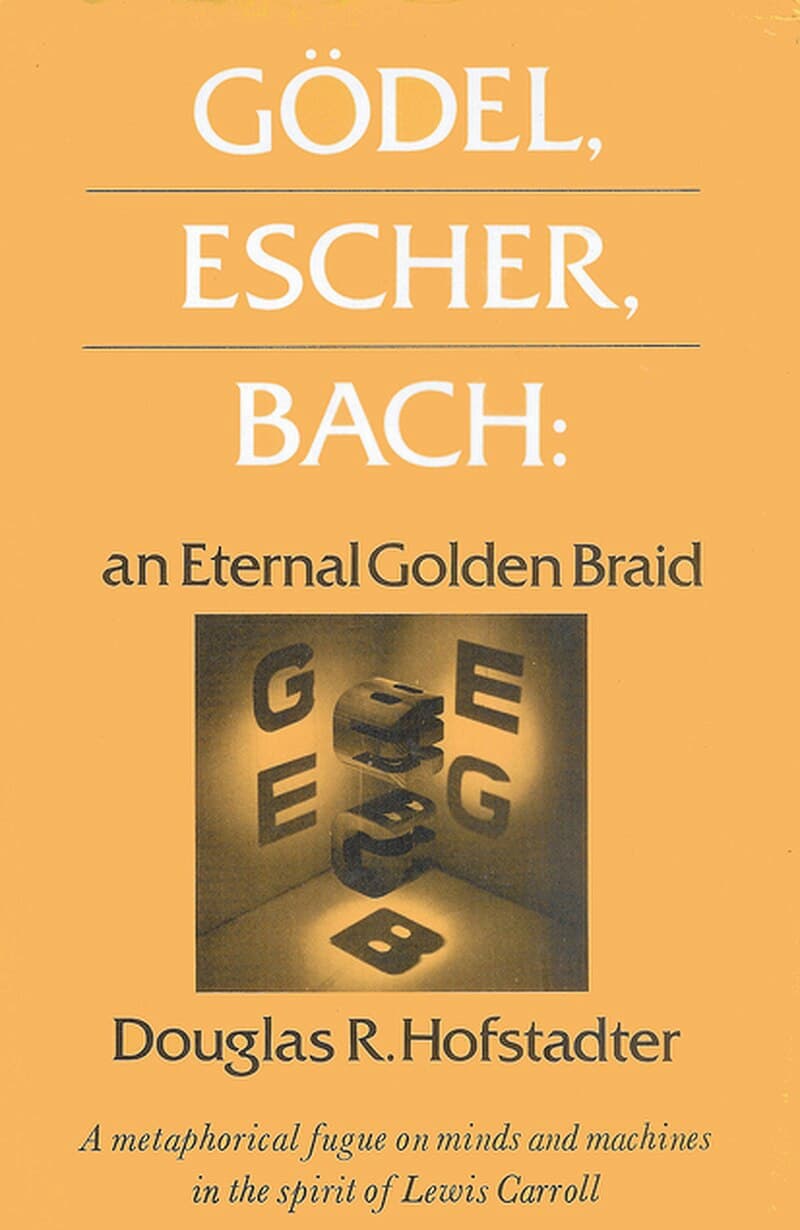
Hofstadter: Gödel, Escher, Bach: An Eternal Golden Braid (photo by Douglas Hofstadter)
In the South Pacific, Polzin was struck by the incredible variety of natural forms, both on land and in the sea. This same infinite variety is how he has come to conceive of Bach, and he fears (and somewhat hopes) that this will be his destiny: to be ever intertwined with the immortal composer.
His first Bach work was a painting, Bach at Pomare IV, created in 1994. He painted one image after another on top of the last, creating an abstract result from layered non-abstract images.
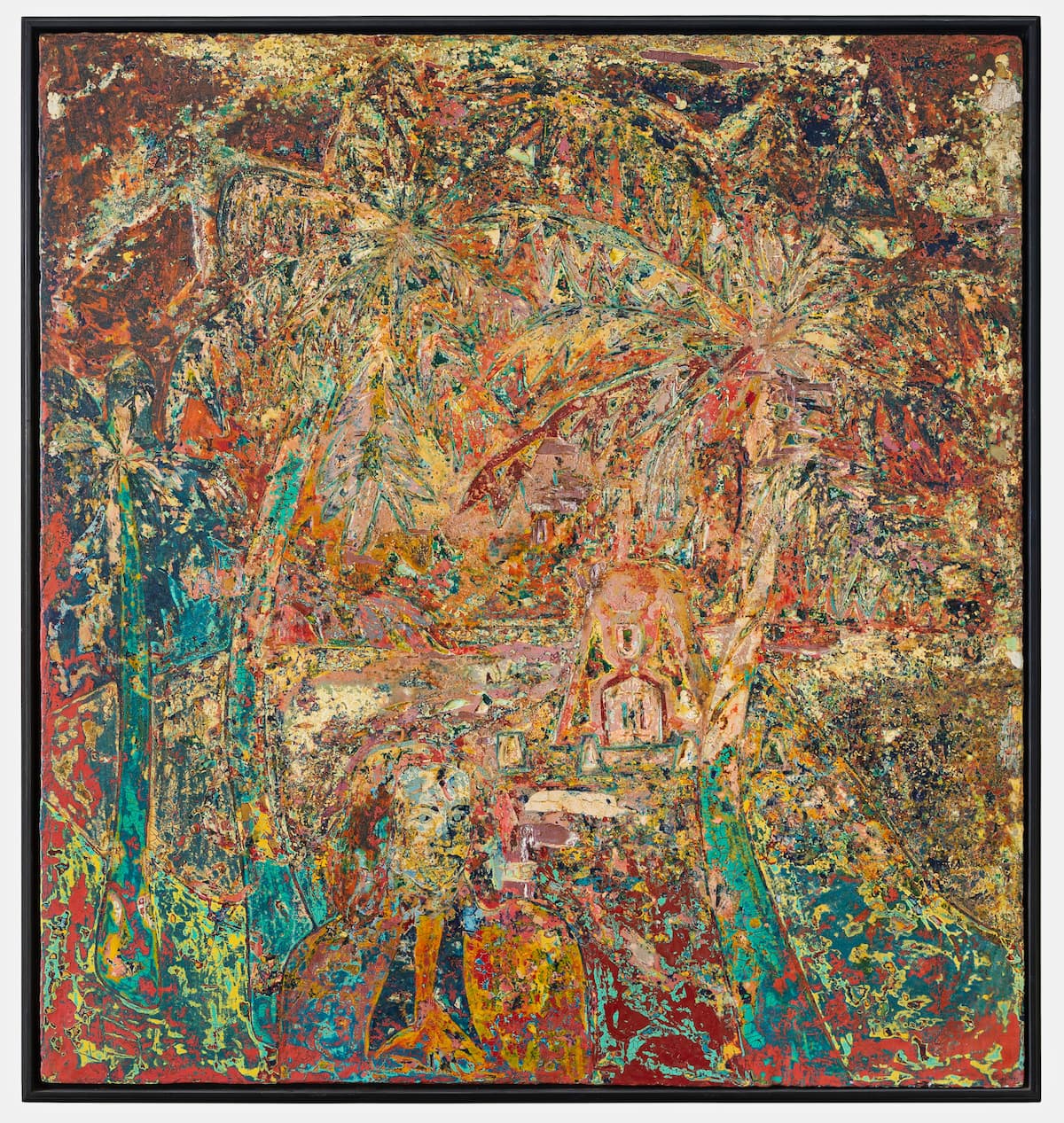
Bach at Pomare IV, 1994 (photograph by the artist)
Once he brought Bach to the world of dimensional sculpture, his freedom to explore knew few bounds. He creates to the music of Bach and his Bach sculptures bring out what he listens to.
With his training as a stonemason, Polzin’s approach to art is through a medium that is particularly difficult to manipulate. It’s large, it’s heavy, and has an individual character. Accordingly, his modelling material is equally difficult. Although most sculptors work in clay before their busts are cast, Polzin works in wood. Specifically oak, one of the hardest woods of Europe. Polzin sources his wood from the trees in the forest, working with the local forester to choose the tree. He said there’s a kind of hubris in this – taking a tree, which is already a work of art and maybe 100 to 150 years old, and then making a different work of art out of it.
Oak is very difficult to work with, starting with the hardness of it wood; in addition, the acid in its wood quickly blunts the woodworking tools. Polzin says he has a dialogue with the wood, seeking how to impose his vision on what is already a perfect sculpture of a tree. Accordingly, there may be many tree elements that come through his sculptures, as in Bach III below.
Bach I, done in blue glass, can glow in the light.

Bach I © Norbert Banik

Bach I, glowing © Norbert Banik
Bach II seems to be connected with the undersea world that Polzin saw in French Polynesia. Bach’s mind is open to the world, taking in everything and channelling it through his polished perception. A brain coral, perhaps?
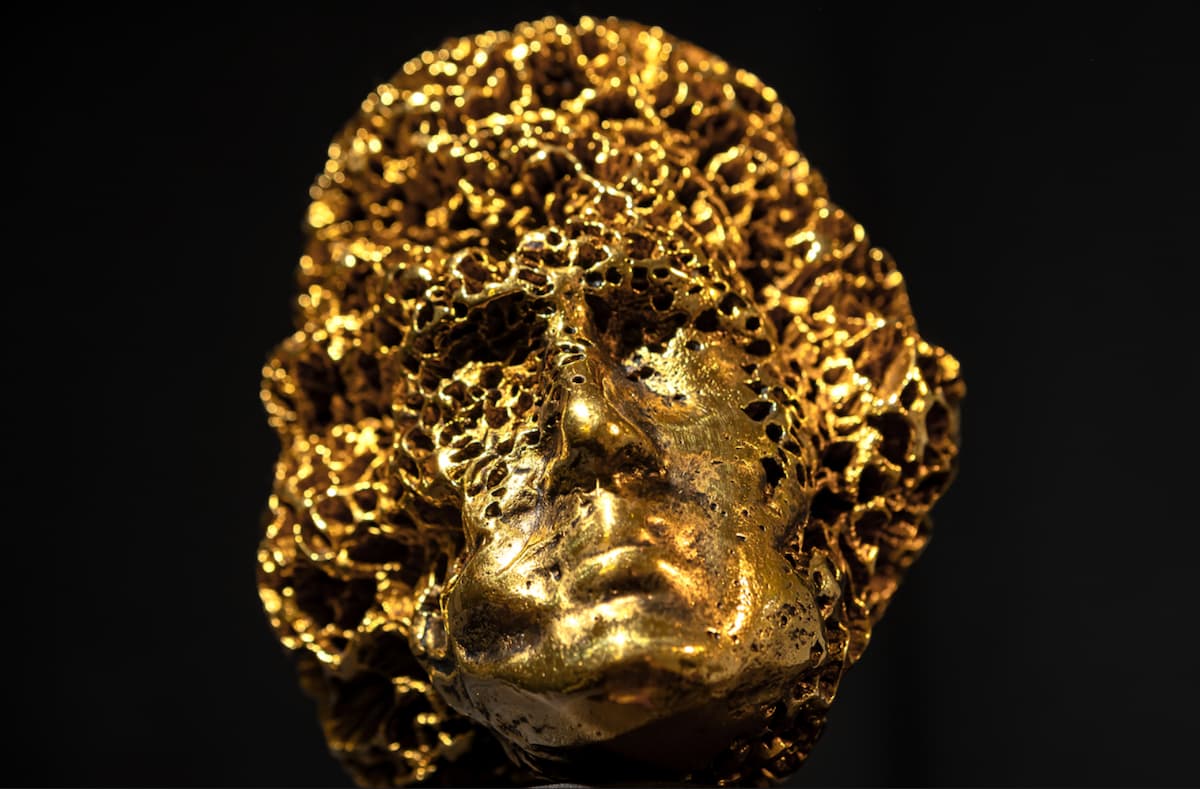
Bach II © Norbert Banik
Bach III, completed in 2023, will be installed at the Royal Academy of Music in London. This is a larger image – if Bach I and II were appropriate for collectors, this Bach is for public display. The texture of the wood is more visible here – both on his cheek and in his hair. This will be displayed on a plexiglass plinth and is intended to be viewed from 360°, including from below. With plexiglass’ ability to capture light, there should also be a glowing effect with this bust.
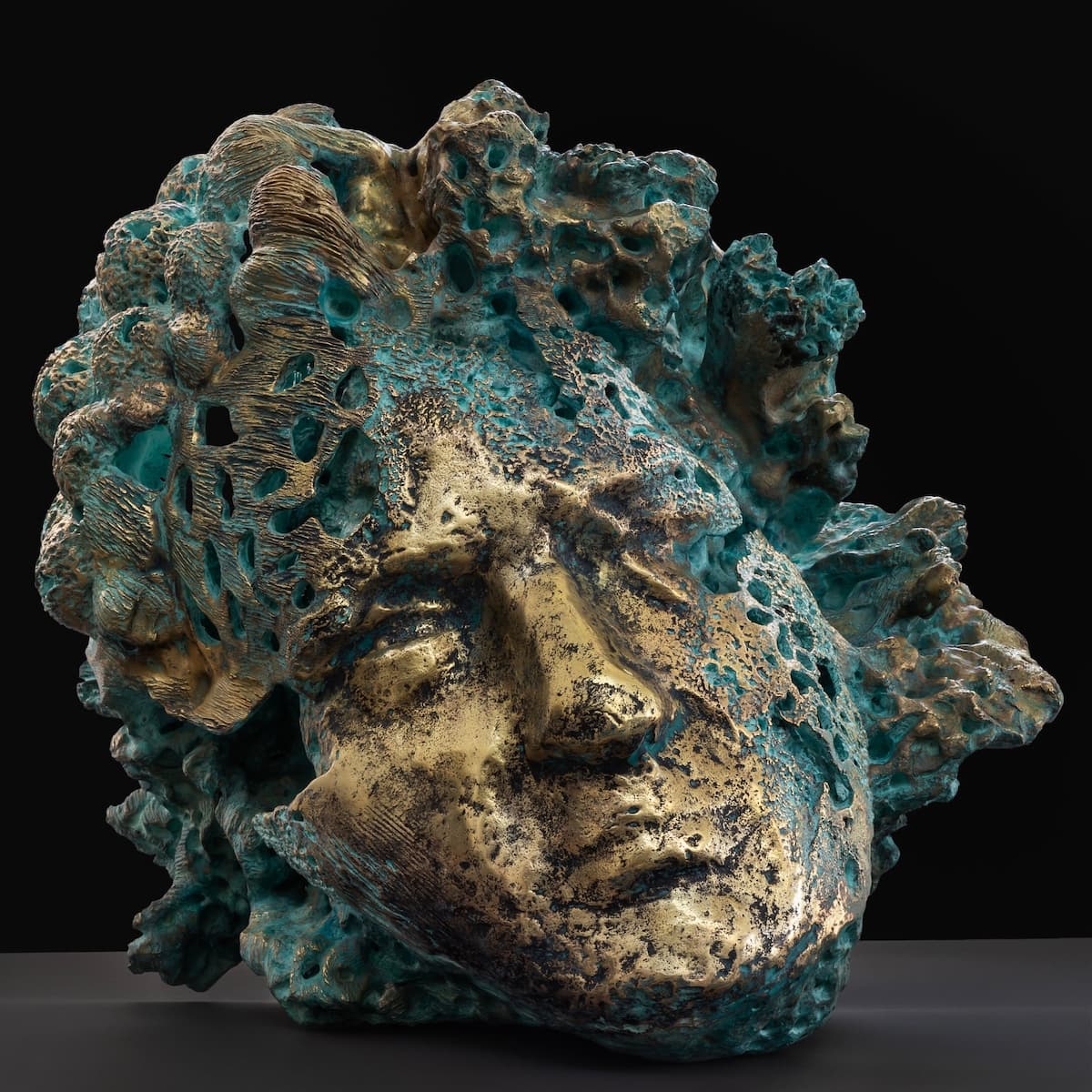
Bach III (photo by Alexander Polzin)
Polzin doesn’t conceive of a unified Bach but a sectional Bach: The Bach of The Art of Fugue is different than the Passion Bach, or the Keyboard Bach. All these different Bach characters may be at the root of Polzin’s inability to focus on one theme for his Bach portraits.
For Polzin, sculpture has the possibility of illustrating contracting or opposing ideas. Whereas poetry cannot put both love and hate in a single word, sculpture can bring these together. When we spoke, Polzin had just received Bach IV from the foundry, and in it he was able to evoke a double Bach.

Bach IV, 2024 (photo by Alexander Polzin)
You can see Back’s profile at the right, but in the centre, you can see another Bach, looking in a different direction. Polzin said that this kind of double imagery, a kind of dimensional cubism, was only achievable in glass.
Another Bach from his hands was the cover for a recording of The Well-Tempered Clavier, arranged for chamber ensemble. Polzin held an exhibition, Bach and Beauty, in New York in 2023 in conjunction with Laurence Dreyfus and Phantasm.
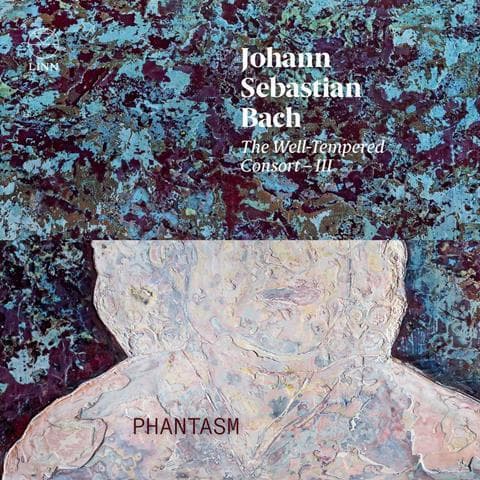
Bach: The Well-Tempered Clavier, 2023 (photo by Alexander Polzin)
As an extension of his playing, Gorini sought a dialogue with the current artists who encounter Bach, including Polzin, pianist Alfred Brendel, stage director Peter Sellars, architect Frank Gehry, cellist Steven Isserlis, mathematician Betül Tanbay, and many others. Each interlocutor comes at Bach from a different perspective, and much like Polzin’s own work on his Bach problem, comes to different conclusions about their work and Bach.
In Paris, Polzin worked with Gorini on an Artists Talk entitled Art of the Fugue, which was an exhibition of Polzin’s work followed by a performance of The Art of Fugue by Gorini. The audience was split between those who had come to see Polzin’s work and those who came for the music. For Polzin, it was interesting observing the audience: those who came for an artist’s exhibition and who ended up in a piano recital started off irritated, annoyed, and impatient to leave. By the end, 90-some minutes later, they were still held, captured by the music.
And so Polzin is held by the contradictions of Bach – Bach the subtle master of counterpoint, Bach the artist of the fugue, Bach the confounder of expectations, Bach the magician.
Polzin’s Bach III will be installed in the foyer of the Royal Academy of Music on 13 June 2024. He is currently working on Bach V.